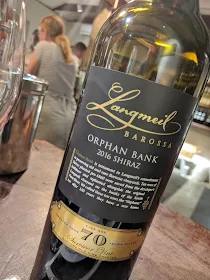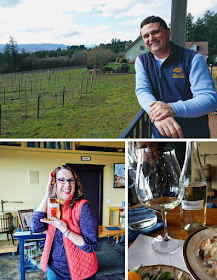Walla Walla and The Rocks District are creating a collaborative buzz in the Pacific Northwest.
Photos and Article
By Dave Nershi, CSW
Vino-Sphere Publisher
Reaching Across Borders
In the Old World countries of France, Italy, Spain and Germany, the boundaries of the highest quality wine appellations are strictly drawn. Not only are there geographic limits, but regulating councils frequently mandate types of grapes, yield levels, alcohol percentages, production methods and more. In fact, the name of the wine region defines the wine style. There are walls as solid as the medieval fortresses that dot the European countryside.
Never Miss A Beat – Follow Vino-Sphere On Facebook
The rules and expectations in the US are decidedly different. Winemakers not only collaborate with those in other parts of the state, but in other states. In Washington and Oregon winemakers are reaching hands across state borders in the quest for exceptional wines. We recently visited to learn more about these unique collaborations.
In Oregon and Washington, three American Viticultural Areas (AVA) span the two states. Columbia Valley is one of the largest appellations in the country and, like the Columbia Gorge AVA, spills across the Columbia River which divides the two states. Although the city of Walla Walla is in Washington State, the Walla Walla AVA crosses into Oregon.
 The Concrete Mama
The Concrete Mama
Not far from downtown Walla Walla’s landmark Marcus Whitman Hotel is the Seven Hills Winery. Seven Hills is one of the oldest and most respected wineries in the region.
Keep up with the latest. Follow us on Instagram!
Its success has deep roots across the state line. The Seven Hills Founding Blocks Vineyard was planted in the 1980s in Oregon and features some of the oldest commercial plantings of Cabernet Sauvignon and Merlot in the Walla Walla AVA. A side-by-side tasting of the 1998 and 2016 Merlot vintages, plus a barrel sample of the 2017 demonstrated the layered flavors and elegance for which Seven Hills is known.
A stroll down Walla Walla’s charming main street will take you to Passatempo Taverna. The restaurant is owned by Mike Martin. Martin and winemaker Ali Mayfield are business partners in The Walls winery. The Walls is a play on the nickname for one of Walla Walla’s most notorious landmarks, the Washington State Penitentiary – also known as “Concrete Mama.”
The Walls winery is in the business of tearing down walls with outstanding wine. Wines like Cruel Summer, a rosé of Grenache and Mourvedre, and the 2016 Curiositas Red Mountain Cabernet Sauvignon, an expansive wine fermented in concrete, are earning The Walls superstar status.
The Walls Concrete Mama Grenache and Syrah wines also display the cross-border handshake. The grapes come from The Rocks District of Milton-Freewater, the only nested AVA in the Walla Walla region. The Rocks District, which officially debuted in 2015, is considered by some to have the most unique terroir in the US.
 Cobblestones And Funk
Cobblestones And Funk
“The area is very young, we are still learning,” says Steve Robertson as he walks through SJR Vineyard, “Usually it takes generations for people to figure things out.” Robertson spearheaded the Alcohol and Tobacco Tax and Trade Bureau petition to gain approval for The Rocks District as a new AVA.
A casual observer would wonder why anyone would plant vines in this soil – or if there is any soil there at all. The soil consists of softball-sized cobblestones made entirely of volcanic basalt rock. The roots of the vines must plunge deeply in search of water. The surface stones collect and radiate heat protecting the vines against colder evening temperatures.
The Rocks District is the only AVA in the US with boundaries drawn based on a single soil series (Freewater). The AVA is 5.9 square miles, a size that is dwarfed by the enthusiasm for wines from The Rocks District. Wines display deep minerality, complexity and funk.
“When you can taste a wine and know where its from, that’s magic,” said Robertson. In addition to providing SJR grapes to some of the premier wine producers, Robertson produces Delmas Syrah. It is produced in micro-quantities and sells out quickly. SJR is a family operation focused on Northern Rhone style wines with daughter Brooke serving as director of viticulture and wife Mary as director of sales.
 Leading The Way To Rocks Growth
Leading The Way To Rocks Growth
One winery that knows the value of cross-state collaboration and the emergence of The Rocks District is Force Majeure. The winery produces ultra-premium reds, primarily from their Red Mountain AVA estate vineyard.
The Force Majeure production facility and tasting room has been in Woodinville, near Seattle. That’s about to change. Recently Force Majeure has acquired a vineyard in The Rocks District and is building a winery and tasting room there in a former schoolhouse. The location is about an hour from Red Mountain and close to SJR Vineyard.
“We’ve been Red Mountain all along,” said Emily Pavela, director of hospitality for Force Majeure about the cross-border migration during a recent tour. “Now we’ll all be in one place.” It’s a good place to be, too. The 2016 SJR Syrah by Force Majeure has amazing nuanced flavors and is acclaimed by critics. It is scarce, with production of only 45 cases.
 From Apples To Hallowed Stones
From Apples To Hallowed Stones
Watermill Winery is in Milton-Freewater, Oregon, and is known not only as a premier producer of estate wines, but also as home of the Blue Mountain Cider Company. It is the largest packer of apples in Walla Walla Valley.
High in the foothills of the Blue Mountains, the Anna Marie Estate Vineyard produces outstanding single vineyard Bordeaux-style reds. Just minutes away is the flagship of the estate holdings. The Watermill Vineyard is the only one of its seven vineyards located entirely within The Rocks District.
While walking through the cobbles of the vineyard, Watermill Commercial Director Alex Hedges explains that excitement about The Rocks District is growing. “There are no tasting rooms currently in The Rocks,” he said. “By next year there will be four.”
Syrah makes up 45% of overall Rocks vineyard plantings, followed by Cabernet Sauvignon and a small percentage of Cabernet Franc. Watermill produces a Rocks Syrah and Cabernet Franc (under its Hallowed Stones label) and a Watermill Mouvedre. The Syrah and Cab Franc are co-fermented with 5% Viognier using a technique popular in France’s Rhone Valley. The quality is sensational, helping to build the reputation of this unique AVA.
Washington and Oregon are blending terroir and winemaking knowledge across boundaries, serving up irresistible premium wines.







 McRitchie is not only gaining national attention for its wine, but this Yadkin Valley producer also is a pioneer in North Carolina cider.
McRitchie is not only gaining national attention for its wine, but this Yadkin Valley producer also is a pioneer in North Carolina cider.
 “You turn the apples into pulp,” explains McRitchie. “Once you have the juice, it’s just like making white wine. Cider is fun.”
“You turn the apples into pulp,” explains McRitchie. “Once you have the juice, it’s just like making white wine. Cider is fun.” The 2017 Petit Manseng Petillant Naturel sparkling wine was a rare treat. This wine is produced using the Ancestral Method, an ancient way of creating sparkling wine by bottling before fermentation is complete. The pet-nat is gloriously cloudy with sediment and a yeasty flavor. This is a bottle that would delight the most jaded wine lover!
The 2017 Petit Manseng Petillant Naturel sparkling wine was a rare treat. This wine is produced using the Ancestral Method, an ancient way of creating sparkling wine by bottling before fermentation is complete. The pet-nat is gloriously cloudy with sediment and a yeasty flavor. This is a bottle that would delight the most jaded wine lover! The wine and cider is reasonably priced, ranging from $14 to $26. The tasting fee is $7 for four wines and two ciders. The tasting room is comfortable and the staff friendly.
The wine and cider is reasonably priced, ranging from $14 to $26. The tasting fee is $7 for four wines and two ciders. The tasting room is comfortable and the staff friendly. 









